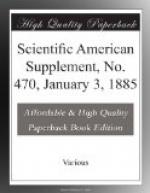The nitrifying organism has been submitted as yet to but little microscopical study; it is apparently a micrococcus.
It is difficult to conceive how the evidence for the ferment theory of nitrification could be further strengthened; it is apparently complete in every part. Although, however, nearly the whole of this evidence has been before the scientific public for more than seven years, the ferment theory of nitrification can hardly be said to have obtained any general acceptance; it has not indeed been seriously controverted, but neither has it been embraced. In hardly a single manual of chemistry is the production of saltpeter attributed to the action of a living ferment existing in the soil. Still more striking is the absence of any recognition of the evidence just mentioned when we turn to the literature and to the public discussions on the subjects of sewage, the pollution of river water, and other sanitary questions. The oxidation of the nitrogenous organic matter of river water is still spoken of by some as determined by mere contact with atmospheric oxygen, and the agitation of the water with air as a certain means of effecting oxidation; while by others the oxidation of nitrogenous organic matter in a river is denied, simply because free contact with air is not alone sufficient to produce oxidation. How much light would immediately be thrown on such questions if it were recognized that the oxidation of organic matter in our rivers is determined solely by the agency of life, is strictly limited to those conditions within which life is possible, and is most active in those circumstances in which life is most vigorous. It is surely most important that scientific men should make up their minds as to the real nature of those processes of oxidation of which nitrification is an example. If the ferment theory be doubted, let further experiments be made to test it, but let chemists no longer go on ignoring the weighty evidence which has been laid before them. It is partly with the view of calling the attention of English and American chemists to the importance of a decision on this question that I have been induced to bring this subject before them on the present occasion. I need hardly add that such results as the nitrification of sewage by passing it through sand, or the nitrification of dilute solutions of blood prepared without special precaution, are no evidence whatever against the ferment




